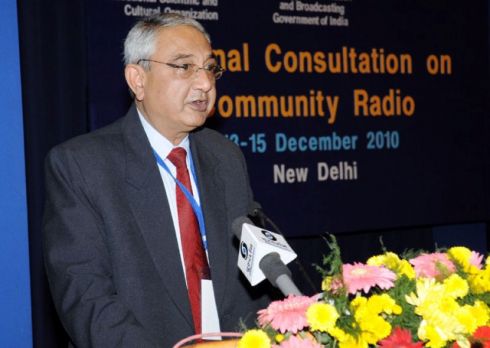
NEW DELHI: Information and Broadcasting Ministry Secretary Raghu Menon today said community radio has to be a two-way medium so that people could make better use of the information being imparted.
He also expressed the hope that community radio stations that have already come up in the country will begin exchanging programmes so that their effectiveness increases. A blueprint plan of action should be set up for networking and content sharing amongst the Community Radio. He also hoped that the content would not only meant for the institution that sets up the community radio, but inhabitants around it.
He also regretted that the community radios at present appeared to be concentrated in around five states, and there were no applications from north east India in this regard.
He said community radio should not be funded by the Government or donors, but should create a system of seed money that can be depended upon. If sustainability of the Community Radio Movement suffered due to lack of funding, the Ministry could consider introducing a new scheme in the 12th Plan to at least provide some quantum of the initial non-recurring cost as 'seed money'.
Menon was speaking at a three-day National Consultation on Community Radio Services which commenced today with the objective of carving out a new roadmap for mainstreaming community radio as an effective outreach tool, not only within the media landscape but also a tool for empowering disadvantaged communities.
Menon said the purpose of the Consultation was to bring about an informed debate about the policy and administrative changes that were necessary to overcome the challenges being faced by Community Radio Stations today. This included cumbersome licensing procedures, dearth of funds for setting up and operationalising such stations, spectrum constraints and the lack of technical and professional training.
He said the Ministry was aware of functional constraints and had undertaken measures to streamline the process. Some of the initiatives included expediting the process of filing applications through online filing system for speedy clearances, awareness generation through workshops and the regular meetings of the Inter Ministerial Committee to expedite the clearances. Due to these initiatives, 263 Letters of Intent (LoI) had been issued and 121 Grant of Permission Agreement with various organizations had been undertaken.
It had also been decided to organise 'Capacity Building Workshops' for the existing Community Radio Stations. This would enable the functioning organisations to develop their skills, content and outreach and become a tool of effective two way communication highlighting the aspirations of the community. As part of the future roadmap, Menon mentioned that community oriented messages could be effectively placed through the integrated efforts of government departments like health, education, rural development, women and child development including programmes such as NRHM, Micro-credit Schemes involving Self Help Groups and NREG Scheme. He added that the content emanating from Community Radio Stations evinced a lot of interest from far flung areas and communities. In such places, the content from the mainstream media evoked little interest and did not cater to the information needs of the region.
UNESCO Director for Division for Communication Development Paris W Jayaweera stated that the growth of the Community Radio movement could be facilitated by incorporating and sharing the best practices of other countries. These included inclusion of certain indicators which facilitated growth such as pricing and structure of licenses not being prohibitive to the growth of such stations, special quotas within the spectrum for Community Radio operations and special pricing norms for community radio tools and equipment.
Joint Secretary (Broadcasting) Arvind Kumar highlighted the initiatives taken by the Ministry in extending the outreach of the Community Radio Stations including the enhancement of scope of eligibility in 2006. Due to this initiative, non Governmental and Community based organisations with at least three years of legal existence were eligible to participate. The license period was increased from three to five years and the bank guarantee was reduced to Rs.25,000 from Rs.50,000. To improve the viability of operations, advertising up to 5 minutes per hour of broadcast was allowed as part of business operational plan.
The consultation seeks to analyse, assess and amend the current Community Radio Policy in achieving the goals of disseminating information, strengthening grass-root democracy and fulfilling social development objectives and discuss issues of financial & social sustainability of Community Radio Stations.
So far 263 Letter of Intents have been issued, 121 Grant of Permission have been signed and 103 Community Radio Stations have been operationalized in various parts of the country. Out of 103 stations, 71 are run by Educational Institutions, 24 by community based organizations and 8 by Krishi Vigyan Kendra/State Agriculture Institutions. There has been a steady increase in the number of operational Community Radio Stations in the country. It has increased from 57 stations in the month of May 2010 to 103 Radio Stations in November 2010.